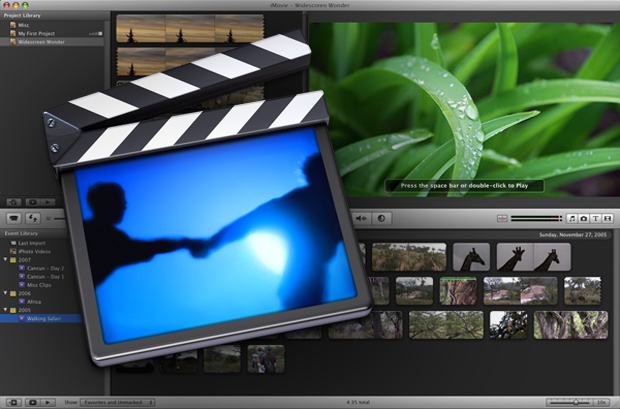Today’s shift towards the vast complexity of digital literacies involves, perhaps more than any other medium, the skills of producing digital videos, including the so-called “fact-based” documentaries and video reports. However, these “facts” are still “made” to fit a rhetorical message with its point of view, narrative structure, and appeals to feelings and emotions. And especially with regards to “what we call ‘documentaries'” digital technologies have strongly “reshaped” their “form, along with” their “potential to produce political effects” (Meg McLagan: “Imagining Impact and the Production of Political Effects,” 2012, p. 306). By acquiring the digital video editing skills using iMovie and Audacity, students can learn how to make their own video reports (or “mini-documentaries”) and thereby acquire an increased critical awareness of the rhetoricity of digital videos.
The goal of this lesson plan is for students to make their own digitally produced videos using iMovie and Audacity. More specifically, students will learn:
- the digital skills for recording audio with Audacity and editing videos with iMovie”
- formulating a rhetorical message in the form of a short video
- an increased critical awareness of the rhetoricity of so-called “fact-based” videos (and their point of view)
Assignment Length
multiple lessons, including much time outside the classroom (this could be a semester-long project)
Required Materials
Audacity and iMovie to use for students, ideally in DWRL digital classrooms; audio recording technology; possibly video recording devices
Skills Necessary
skills needed by teacher (and will be learned by students): Audacity, iMovie, audio and video recording; video editing
Access and Adaptability
The students need access to iMovie, Audacity, ideally an audio recording ‘studio,’ and possibly video recording devices. Ideally, the DWRL facilities and software is used for this.
Assignment Description
Since the goal of this lesson plan is for students to make their own digitally produced videos, it will most likely take several weeks to finish it (this can be a semester-long project). Only few in-class sessions are required, but depending on the teacher’s/students’ preferences, class time can be used to work on projects.
In general, this lesson plan is very flexible about how to achieve the goal of the final video; it can therefore be adjusted according to teacher’s/students’ wishes. However, it should include at least one initial lesson to start off the project and at least on final lesson for the presentation of the final videos.
Instructor Preparation
- choose examples to show of controversial video reports/documentaries” type
- skills for using iMovie
- skills for using Audacity (including how to use audio recording devices)
Student Preparation
no preparation required
In-Class or Assignment Instructions
LESSON 1: ORIENTATION
1. Students watch for homework examples of controversial video reports or documentaries (such as Michael Moore’s ‘Bowling for Columbine’; for more suggestions click here for a list of controversial documentaries).
2. In-class discussion with students about aspects of rhetoricity (point of view, narrative structure, appeals to emotions/feelings etc.); goal: students acquire a sensibility for how every “fact-based” report is still guided by a certain interest.
3. Teacher introduces instructions for project with specifics about content, deadlines, and collaboration details
Instructions (can be modified): students work in pairs; decide for topic of their own choosing (ideally something controversial, which necessitates a specific point of view, such as ‘guns on campus’ or ‘abortion’; but can also be informational about, e.g., the UT campus; or students may also choose their RHE 306 ‘controversies’); final products need to be 3-8min long; use video footage either from YouTube (or similar platforms) or create your own footage (e.g. with smart phone cameras; also, the DWRL or the UT library can offer a few cameras for check-out); students record their own voice through Audacity in DWRL facility (or at home): this recording will function as “voice over” for the video giving details and facts about their controversial issues.
LESSON 2: PLANNING AND GETTING STARTED
Students choose their topic and develop a script for the video: ‘What message do you want to convey? Find some data/facts about your topic (on computers in DWRL classroom).
LESSON 3 (or outside the classroom): FIND VIDEO FOOTAGE
Students search for footage for their topic online; or they record their own video footage with cameras (their own, or checked out from the DWRL or the UT libraries)” type=”angle-right” link_enabled=”false” link_url=”#” link_new_tab=”false”]Students search for footage for their topic online; or they record their own video footage with cameras (their own, or checked out from the DWRL or the UT libraries)
LESSON 4 (or outside the classroom): EDIT VIDEOS
edit video footage down to the actual video length
LESSON 5 (or outside the classroom): RECORD AUDIO
students record their “voice overs” for the documentary videos, using Audacity (and if possible DWRL recording devices/facilities)
LESSON 6 (or outside the classroom): VIDEO + AUDIO
add your voice overs to the video and make final edits to video
LESSON 7
Presentations of Videos in class (can be accompanied with peer-review feedback)

The following DWRL produced tutorials give you simple introductions to the basic skills for using Audacity and iMovie. The first two video are about Audacity, the following three deal with iMovie; the last tutorial shows you how to add a new audio file to your video.
Assessment Suggestions
While it is more difficult to evaluate the aesthetics of student produced videos, the final products can still be assessed with regards to how their audio supports the overall rhetorical message and how convincing the video is as a whole. Students may also be required to submit a final essay in which they explain their video productions.
This project can be assessed with regards to, first, the final project, second, their final essay (explaining their videos), and third, the peer-review students provide for each other.The video can be assessed regarded how convincing it is with regards to the overall message.

